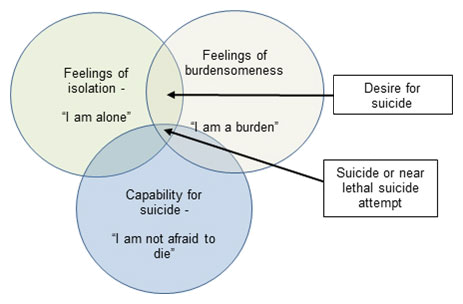A conceptual framework for suicidality
The CAF recognizes that suicidality is a complex, multi-dimensional human phenomenon “…involving biological, psychological, social, cultural, spiritual, economic and other factors, such as the physical environment in which people live (ref A).” Suicidality is frequently the result of the intersection of a number of risk factors amplifying each other rather than any one factor. Given the complexities, it would be unrealistic to think that the CAF can fully control or eliminate all these factors, culminating in the elimination of suicide. Notwithstanding this reality, the CAF has taken the position that “one suicide is too many” and will seek to address all the risk factors and protective factors that are within its ability to control or influence.
The CAF SPAP will be informed by Thomas Joiner’s Interpersonal Theory of Suicide. The theory provides an explanation of why certain people engage in suicidal behaviour. The model proposes that there are three necessary elements that combine to create the potential for suicide as modelled in Figure 1, below.
Interpersonal theory of suicide

Figure 1. Thomas Joiner’s Interpersonal Theory of Suicide
Diagram of Interpersonal Theory of suicide. Three interlocking circles state:
1 - Feelings of Isolation; 2 - Feelings of burdensomeness; 3 - Capability for suicide.
A fundamental need of humans is having feelings of belongingness. Feeling accepted by others and part of a social structure is believed to be a fundamental human need, and an essential component of mental health and well-being. Social isolation then becomes a risk factor for suicidality while social connectedness is a protective factor.
Another fundamental human requirement is the need to feel valued and useful. The belief that one is a burden can lead to the perception that those close to the individual “would be better off without him/her.” Financial problems, medical issues, incarceration, or various combinations of a number of problems can lead to distorted perceptions, thereby increasing risk.
The model indicates that the first two elements, the feelings of isolation and the feelings of burdensomeness, can combine to produce a “desire for suicide”, or suicide ideation. This desire, however, is not sufficient to carry out or attempt to carry out a suicide. Fear of death, including by suicide, is a natural and extremely powerful human instinct. The theory proposes repeated exposure to traumatic events, engaging in self harm behaviour and suicide ideation may desensitize and habituate the individual and increase the capability for suicidal behaviours. This may be why a history of attempted suicide is the number one predictor of future attempts. Also, certain professions such as military personnel, police, first responders and surgeons who are exposed to combat, physical pain and/or traumatic experiences, may have a higher risk of suicide.
The Interpersonal Theory of Suicide provides a model that can be used to help understand the risks of suicide. It implies that reducing suicidality cannot merely consist of clinical health interventions, but must also include preventative measures such as actively promoting CAF member well-being, while addressing key environmental stressors using a systemic approach.
In line with that approach, the CAF used a systemic model of health based on the Public Health Agency of Canada model that describes 12 core determinants of health. These determinants, displayed in Figure 2, helped inform the joint strategy and the CAF SPAP.

Figure 2. The 12 Core Determinants of Health
A colour wheel listing the 12 Core Determinants of Health:
1 - health services; 2 - employment/working conditions; 3 - education and literacy; 4 - physical environments; 5 - social support networks; 6 - personal health practices and coping skills; 7 - social environments; 8 - healthy child development; 9 - biology and genetic endowment; 10 - culture; 11 - financial and social status; 12 - gender.